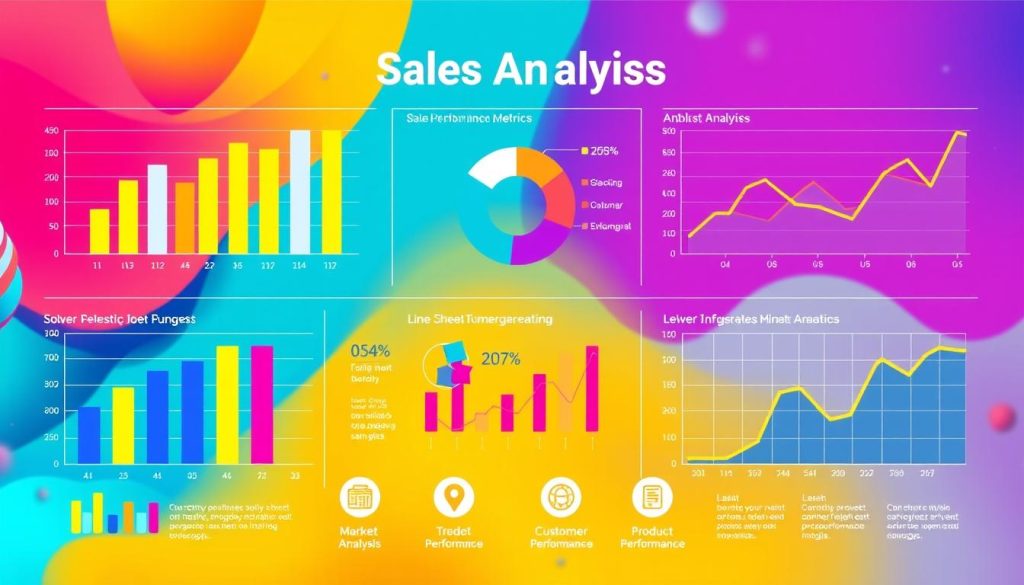Sales analysis is crucial in today’s data-driven business world. It helps organizations boost revenue growth and improve decision-making. Various techniques allow companies to explore their sales data and uncover valuable insights.
Sales analysis empowers professionals to make informed choices and spot emerging trends. It helps identify untapped opportunities within the sales pipeline. Mastering this skill can give you a competitive edge in your industry.
This article explores different types of sales analysis and their applications. We’ll cover the basics of sales data and dive into customer behavior. We’ll also look at product performance and other key elements of a solid analysis strategy.
Key Takeaways
- Discover the different types of sales analysis and how they can provide valuable insights for your business
- Understand the importance of sales analysis in driving revenue growth and improving decision-making
- Learn how to set up an effective sales analysis framework to uncover hidden patterns and opportunities
- Explore the key performance indicators (KPIs) and metrics that are crucial for sales performance analysis
- Gain insights into customer behavior and optimize your sales funnel through pipeline analysis
- Dive into product sales analysis to maximize your portfolio performance and identify trends
- Leverage geographical sales data to enhance your territory management and distribution strategies
Understanding the Fundamentals of Sales Analysis
Data-driven insights are crucial for optimizing sales performance. Sales analysis helps businesses make informed decisions. It allows companies to navigate the changing marketplace with precision.
Key Components of Sales Data
Effective sales analysis requires understanding key data components. These include revenue, order volume, average order value, and conversion rates. Customer lifetime value is also important.
Examining these data points reveals patterns and areas for improvement. This allows businesses to make strategic adjustments for sustainable growth.
Why Sales Analysis Matters
Sales analysis is more than just tracking numbers. It aligns sales strategies with broader business goals. Data-driven insights help optimize sales processes and refine target audiences.
Organizations can allocate resources more effectively with proper analysis. This leads to improved profitability and long-term success.
Setting Up Your Analysis Framework
A robust analysis framework is vital for extracting meaningful insights. This involves defining clear objectives and selecting the right metrics. Implementing effective data collection and reporting processes is also crucial.
A structured approach ensures actionable intelligence for strategic decision-making. This helps businesses make the most of their sales analysis efforts.

Mastering sales analysis fundamentals unlocks your organization’s true potential. It helps identify growth opportunities in the changing sales landscape. Embracing data-driven insights drives sustainable success for businesses.
Types of Sales Analysis and Their Applications
Sales analysis unlocks valuable insights for businesses. It helps drive strategic decisions and improve performance. Let’s explore different analytical approaches and their applications for sales success.
Comprehensive Sales Analysis
Comprehensive sales analysis provides a holistic view of your sales data. It examines revenue, volume, and profitability. This approach helps identify trends and patterns in your sales performance.
By analyzing these factors, you can spot anomalies and optimize strategies. Comprehensive analysis informs decision-making and enhances overall sales performance.
Segmented Sales Analysis
Segmented sales analysis breaks down data into specific categories. These may include product lines, customer demographics, or geographic regions. This method uncovers unique insights about your target market.
By examining these segments, you can tailor your sales efforts. It allows you to meet the specific needs of different customer groups.
Sales Trend Analysis
Sales trend analysis identifies long-term patterns and predicts future performance. It examines historical data to detect seasonal fluctuations and evolving customer preferences. This approach helps you spot emerging market opportunities.
By using trend analysis, you can make informed decisions. It enables you to stay ahead of the competition in your market.
| Type of Sales Analysis | Key Insights | Applications |
|---|---|---|
| Comprehensive Sales Analysis |
|
|
| Segmented Sales Analysis |
|
|
| Sales Trend Analysis |
|
|
Understanding different types of sales analysis gives businesses a competitive edge. It helps optimize strategies and drive growth. These insights empower sales teams to achieve remarkable success.

Mastering Sales Performance Analysis
Sales data analysis is vital for team optimization and business growth. We’ll explore key performance indicators, team metrics, and individual sales rep analytics. These tools offer valuable insights for data-driven decision-making.
Key Performance Indicators (KPIs)
Choosing the right KPIs is crucial for sales performance analysis. Important metrics include sales revenue, win rate, and average deal size. Customer lifetime value is another key indicator to track.
These KPIs provide a comprehensive view of your sales performance. They help identify areas that need improvement and guide strategic decisions.
Team Performance Metrics
Team-level metrics reveal the collective effectiveness of your sales force. Key indicators include team quota attainment and lead conversion rates. The average sales cycle duration is also important to monitor.
These metrics help identify top-performing teams and highlight any challenges. They provide insights for improving overall team performance.
Individual Sales Rep Analytics
Analyzing individual sales rep data uncovers growth opportunities. Track metrics like quota attainment, activity levels, and pipeline velocity. These indicators help identify high performers and those needing support.
This sales data analysis informs coaching and talent management strategies. It helps optimize individual performance and contributes to overall team success.
Mastering these techniques provides deep insights into your sales operations. It enables informed decision-making and drives better business outcomes. Continuous analysis and improvement lead to sustained sales growth.

Sales Trend Analysis: Identifying Patterns and Opportunities
Sales trend analysis is key for smart business choices. It helps find patterns and opportunities in sales data. Companies can use this info to improve products, marketing, and resource use.
The process looks at sales figures over time. Charts and graphs show trends, seasonal changes, and growth areas. This helps leaders make smart moves to boost good trends.
One key part is sales forecasting. Past data helps predict future sales. This aids in budgeting, inventory, and planning. It ensures businesses can meet changing customer needs.
| Metric | Description | Importance |
|---|---|---|
| Sales Growth Rate | The percentage change in sales over a specific period, typically year-over-year or quarter-over-quarter. | Indicates the overall trajectory of the business, helping identify growth opportunities and areas for improvement. |
| Sales Velocity | The rate at which sales are converted from leads or opportunities. | Provides insights into the efficiency of the sales process, which can inform pipeline management and sales team performance. |
| Customer Retention Rate | The percentage of customers who continue to do business with the company over a given period. | Reflects the strength of customer relationships and the effectiveness of customer service and loyalty programs. |
Sales trend analysis helps businesses make smart choices. It improves overall performance and sets up long-term success. Data-driven decisions are the key to staying ahead.
Sales Pipeline Analysis: Optimizing Your Sales Funnel
Sales pipeline analysis is vital for businesses aiming to improve their sales funnel. It reveals key insights that can help identify bottlenecks and boost conversion rates. This analysis enables informed decisions to enhance your sales process.
Pipeline Velocity Metrics
Pipeline velocity metrics are crucial in sales pipeline analysis. They show how efficiently your team moves prospects through the sales funnel. These metrics include average time to close deals and overall win rate.
By tracking these metrics, you can spot areas for improvement. This allows you to create strategies that speed up your sales cycle.
Conversion Rate Analysis
Analyzing conversion rates at each sales stage is key. It helps you understand where and why potential customers drop off. Sales pipeline analysis pinpoints stages with low conversion rates.
This insight allows you to create targeted interventions. These interventions can boost the effectiveness of your sales efforts.
Deal Size Distribution
Examining deal size distribution offers valuable insights into your data analysis. It helps identify opportunities to upsell or cross-sell. You can adjust your sales strategies based on this information.
Understanding deal sizes ensures efficient resource allocation. This maximizes revenue generation for your business.
Comprehensive sales pipeline analysis empowers your team to navigate the sales funnel better. It helps optimize conversion rates and drive sustained business growth. Use these insights to refine your sales approach.

Customer Sales Analysis: Understanding Buyer Behavior
Grasping customer behavior is crucial for sales success. Customer sales analysis offers vital insights into buyer habits. It helps businesses make data-driven choices and create targeted strategies.
Customer segmentation is key to effective customer sales analysis. It involves grouping customers based on shared traits and buying patterns. This approach reveals customer needs, motivations, and pain points.
Segmentation enables businesses to offer personalized experiences. This fosters loyalty and boosts revenue growth. It’s a powerful tool for understanding your audience.
Customer sales analysis also highlights customer lifetime value (CLV). CLV shows the long-term profit potential of customer relationships. It helps companies allocate resources wisely and prioritize high-value customers.
CLV analysis guides strategies for increasing retention and repeat business. It’s a vital metric for sustainable growth.
| Metric | Description | Importance |
|---|---|---|
| Customer Lifetime Value (CLV) | The predicted revenue a customer will generate during their lifetime | Helps businesses focus on high-value customers, improve retention, and make informed investment decisions |
| Customer Acquisition Cost (CAC) | The total cost of acquiring a new customer | Provides insights into the profitability of customer relationships and the effectiveness of marketing efforts |
| Customer Churn Rate | The percentage of customers who discontinue their relationship with a business | Highlights areas for improvement in customer experience and retention strategies |
Customer sales analysis empowers businesses to make smarter choices. It helps optimize sales strategies and build stronger customer connections. The result? Sustainable growth and lasting success.
Product Sales Analysis: Maximizing Portfolio Performance
Product sales analysis uncovers insights to transform your product portfolio. It optimizes sales efforts and drives impressive results. This approach can revolutionize your business strategy.
Product Mix Analysis
Analyzing your product mix is crucial for success. Identify top sellers, steady performers, and underperforming items. This data informs decisions about product development, pricing, and inventory management.
Product Profitability Metrics
Examining product profitability metrics is vital for product sales analysis. Look at gross margin, contribution margin, and net profit per product. This helps pinpoint your most lucrative offerings and guide resource allocation.
Seasonal Performance Patterns
Seasonal trends greatly affect sales performance analysis. Recognizing cyclical sales patterns helps anticipate demand. It also allows for better inventory management and promotional campaign timing.
These techniques can transform your product portfolio. They optimize it for sustained growth and profitability. Use these insights to unlock your sales data’s full potential.
Sales Territory Analysis: Geographical Performance Insights
Sales territory analysis helps businesses optimize their strategies using geographical data. It uncovers untapped market potential and informs resource allocation. Companies can identify high-growth markets and develop targeted approaches for local dynamics.
Understanding unique characteristics and buying behaviors in each territory is crucial. Rigorous analysis reveals strong performance areas and emerging trends. It also highlights sales discrepancies across regions.
This data-driven approach empowers sales leaders to make informed decisions. It helps refine go-to-market strategies and drive sustainable growth.
Territory analysis identifies underserved markets and guides sales territory realignment. It also enhances channel partner performance. These insights help navigate the evolving sales landscape.
By using geographical data, businesses can maximize their sales potential. They can stay ahead of competitors and deliver exceptional customer experiences across regions.




